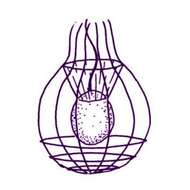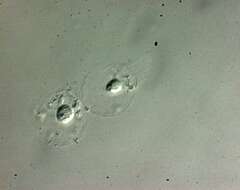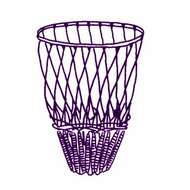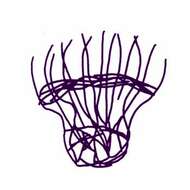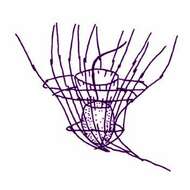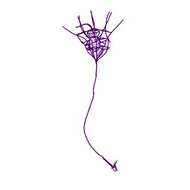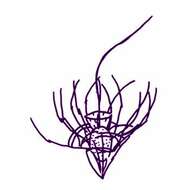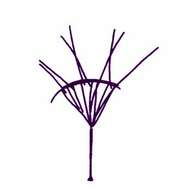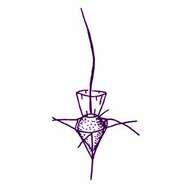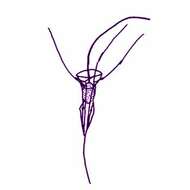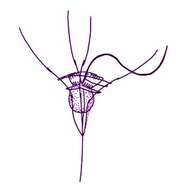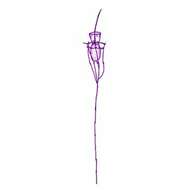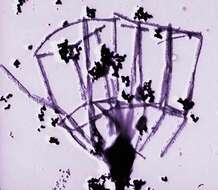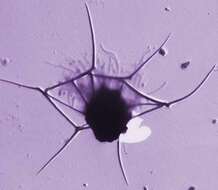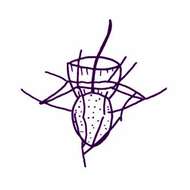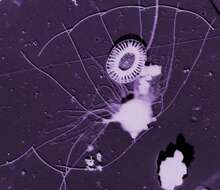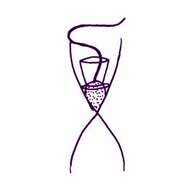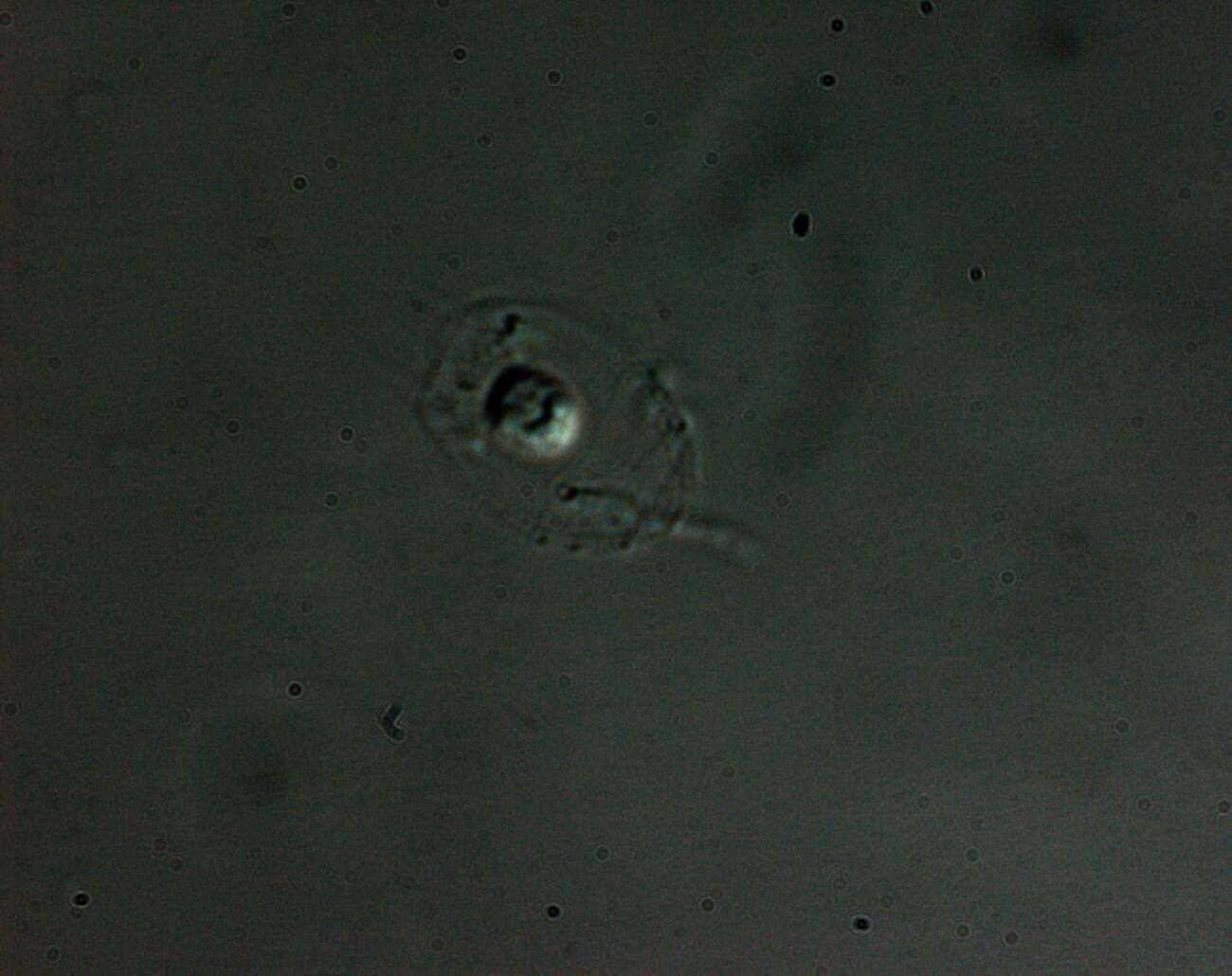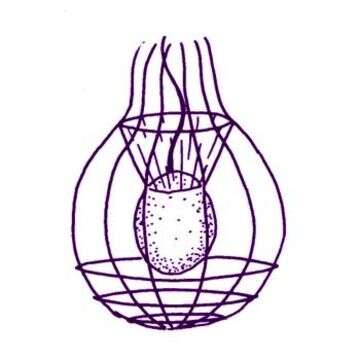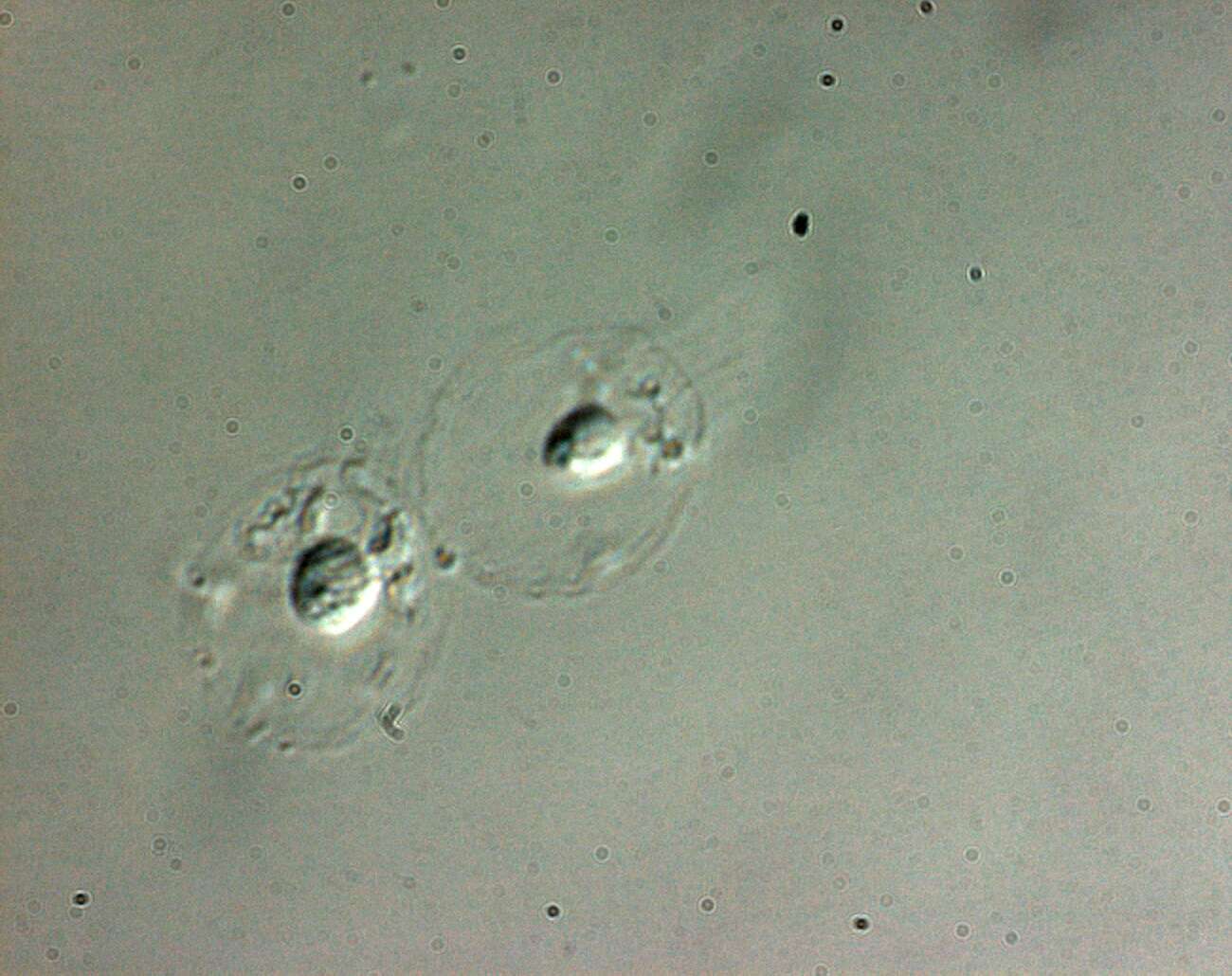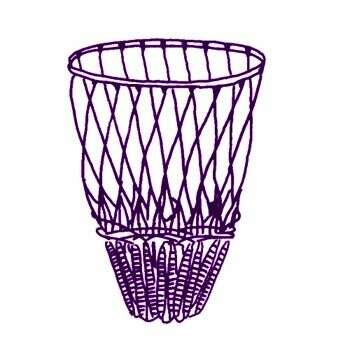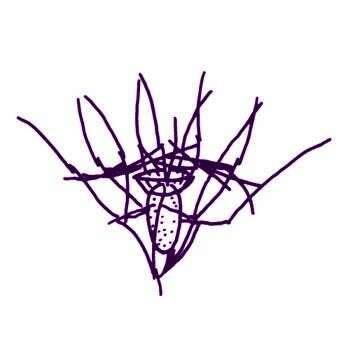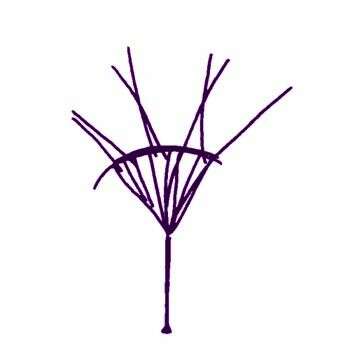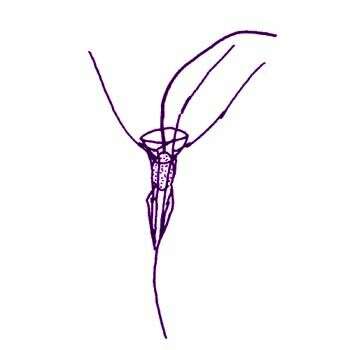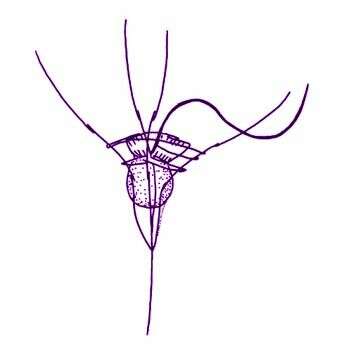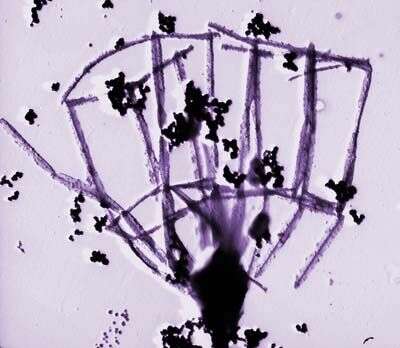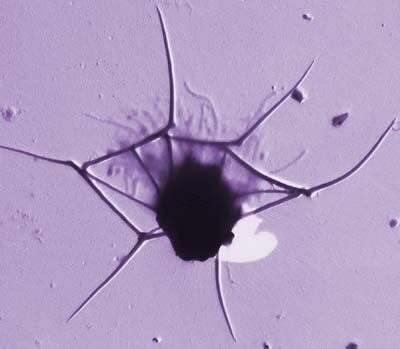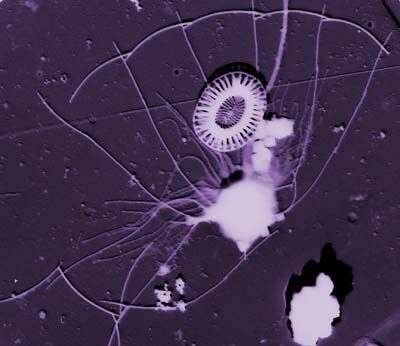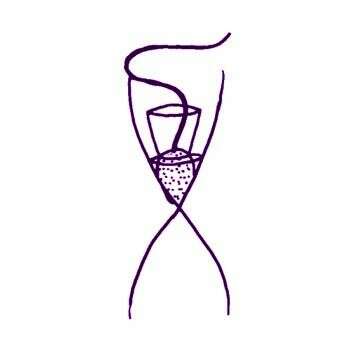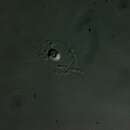-
-
Description: Українська: Схематичне зображення Diaphanoeca grandis. Date: 10 February 2020. Source:
https://eol.org/media/10370159. Author: Won Je Lee.
-
-
Diplotheca costata Valkanov, 1970. The lorica is composed of two quite distinct chambers. The anterior chamber contains 18 longitudinal costae, each being formed by two costal strips with spatulate ends. A transverse costa containing six flattened costal strips forms the anterior ring and another composed of crescentic strips marks the boundary between the two chambers. The posterior chamber contains 10 broad and flattened costal strips with rounded ends. Each strip has a more opaque central region, on either side of which is a thinner region bearing a row of narrow transverse markings.
-

Calliacantha frigida Thomsen, Garrison and Kosman, 1997. Choanoflagellates cells which occur as individuals. The cell body is about 4 x 8 microns long, with a pointed posterior end. The single flagellum (about 30 microns) is surrounded by a ring of tentacles that form the collar. The conical lorica chamber (10 - 14 microns long) consists of 2 transverse costae and 6 (7) longitudinal costae. The transverse costae (diameter about 5 and 4 microns respectively) are closely spaced (1 - 2 microns) at the anterior chamber end. Six rather short costal strips (about 4 microns) form part of the anterior transverse costa, whereas the posterior transverse costa appears to consist of fewer costal strips. Anterior transverse and longitudinal costal strips form E-joins. Each longitudinal costa is composed of two costal strips, each 6 - 8.5 microns long. The costae continue above the anterior transverse costa forming projections that become narrower and are about one costal strip in length (about 9.5 - 12.5 microns). The projections in the living cell lie almost perpendicular to the longitudinal axis of the lorica. The number of longitudinal costae is less towards the hind end of the lorica chamber due to the amalgamation in pairs and threes of costal strips. The lorica is terminated by an aggregated pedicel formed of 3-5 bundled costal strips are each 7 - 9.5 microns long. They have swollen and clawed posterior tips and they often diverge to form a larger holdfast area. A protoplast suspensory membrane extends from the base of the lorica chamber to the level of the posteriormost transverse costa. Replication tectiform.
-
Acanthocorbis apoda (Leadbeater, 1972) Hara and Takahashi, 1984. Cells are 4-6 microns in length, with a truncated anterior, and the posterior end may be pointed. Lorica 13-18 microns long with a constricted posterior chamber, and 12-16 projections protruding from the wider anterior chamber. A single transverse costa in the anterior chamber, formed of overlapping strips, and two or three transverse costae in the posterior chamber. Cells are located in the posterior chamber of the lorica, with the flagellum extending to the top of the lorica or just beyond it.
-
Acanthocorbis campanula (Espeland, 1986) Thomsen in Thomsen et al., 1991. Cells are located at the posterior of a cone-shaped lorica. Lorica 12-16 microns long, pointed posteriorly and widest anteriorly, with two transverse costae and 7-9 longitudinal costae which project above the lorica as projections.
-
Acanthocorbis haurakiana Thomsen in Thomsen et al., 1991. Conical lorica 20-27 microns long, including a posterior spine. One transverse costa at the anterior of the lorica, with the most anterior costal strip of each of 6 longitudinal costae projecting as a spine. The costal strips forming the anterior spines and the posterior spine are tapered distally. There is a band of rather obliquely arranged costae around the protoplast in the middle of the main lorica chamber.
-

Acanthocorbis asymmetrica (Thomsen, 1979) Hara and Takahashi, 1984. Cell solitary, planktonic. Protoplast 4 x3 microns, flagellum 6-9 microns long, surrounded by a ring of tentacles. Protoplast lodged in a lorica 15 -20 microns long, diameter at level of anterior transverse costa approximately 8 microns Lorica composed of 15-17 longi tudinal costae, which converge at the posterior end to form a stalk (4-11 microns long). The location of the stalk deviates markedly from the long axis of the cell, giving it an asymmetrical appearance (hence the specific epithet). Each longitudinal costa consists of four costal strips. The longitudinal costae project anteriorly as free spines (one and a half costal strips long). Two transverse costae (separated by one-third of a longitudinal costal strip) encircle the lorica at the anterior end, the lower-most is connected to the junctions between the second and third longitudinal costal strips (counted from the anterior lorica end). A single transverse ring is attached to the junctions between the third and fourth longitudinal costal strips (counted from the anterior lorica end). The complexity of the strip arrangement in the posterior part of the lorica is somewhat variable, depending on the number of strips entering the upper part of the stalk.
-
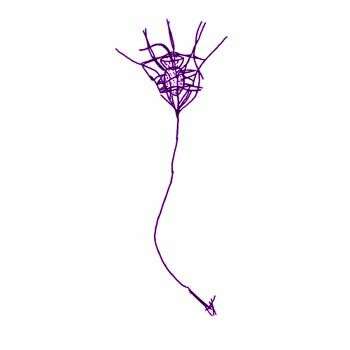
Acanthocorbis prolongata Thomsen et al., 1997. Cells are solitary, attached to the substratum by means of a cluster of costal strips terminating a simple pedicel, about 30 microns long and consisting of up to 8 linearly arranged costal strips. Lorica funnel shaped, about 13 microns long, and with anterior projections (8-10) that continue downwards as longitudinal costae. The length of an anterior projection equals one costal strip. The anterior transverse costa (diameter about 5 microns) consists of 8-10 strips with considerable overlaps between neighbouring strips and a small vertical displacement (about 0.4 microns) between strips where they attach to or cross a longitudinal costa. Costal strip arrangement at the posterior lorica end is somewhat more irregular, although 2 transverse costae are discernible. Costal strips are rod-shaped, and 3-4 microns long. The protoplast, about. 4x3 microns, is posteriorly located within the lorica. The single flagellum is about 7 microns long, surrounded by a ring of tentacles (each about 2 microns long), and with a conspicuous hairpoint.
-
Acanthocorbis weddellensis Thomsen, Garrison and Kosman, 1997. Cells are solitary. Lorica funnel shaped, about 15 microns long, and with anterior projections (12-14). The length of an anterior projection almost equals two longitudinal costal strips in length. Each longitudinal costa consists of 4 costal strips. Two anterior transverse costae (diameter about 7 microns) encircle the lorica at the level of the front end of the protoplast. A single transverse costa encircles the posterior part of the lorica. The lorica has no pedicel. Costal strips are rod-shaped, and about 5 microns long. The single flagellum is about 20 microns long, surounded by a ring of tentacles (each about 3 microns long), and with a conspicuous hairpoint.
-

Apheloecion antarctica Thomsen, Garrison and Kosman, 1997. Cells are solitary. The cell (4-6 x 3-4 microns) posteriorly is finely pointed and has its maximum diameter anterior to the level of the single transverse costa. The single anterior flagellum (11-17 microns long) is surrounded by a ring of tentacles forming a collar. The 5-7 longitudinal costal strips forming the lorica chamber continue above the transverse costa forming finely attenuating and pointed spines (about one half costal strip long). Posteriorly they join in two groups of 2-4 costal strips, each group attaches one strip from the pair of extended costal strips forming the pedicel. The single transverse costa consists of 5-6 costal strips which are each 2-3 microns long. Patterns of costal strip attachment at the anterior lorica end appear to vary. The exceptionally long pair of costal strips forming the pedicel measures 12-30 microns The middle part of these costal strips is very narrow, whereas both ends of the strips are somewhat swollen, most conspicuously at the posterior tip. A protoplast suspensory membrane is present. Cell division caudiform.
-
Apheloecion conicoides Thomsen, Garrison and Kosman, 1997. Cells are solitary. The simple lorica is about 14 microns in overall length and consisting of a total of about 20 costal strips arranged to form a lorica chamber with 7 anterior projections (6-6.5 microns long) and a simple pedicel (about 6 microns). Costal strips forming projections narrow from base to tip. The posterior tip of the costal strip forming the pedicel is enlarged to form a triangular holdfast. The lorica chamber consists of 12 longitudinal costal strips (5-5.5 microns long) surmounted by a single transverse costa (diameter about 5 microns). Tectiform division.
-
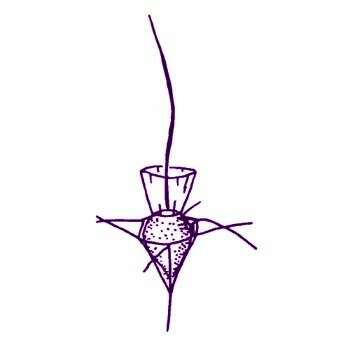
Apheloecion glacialis Thomsen, Garrison and Kosman, 1997. Cells are solitary. The cell (5-9 x 3-5 microns) tapers posteriorly and has its maximum diameter at the level of the single transverse costa. The single anterior flagellum (20-30 microns) is surrounded by a well-developed ring of tentacles (4-5 microns long). The lorica is simple, consisting of a total of 19 costal strips arranged to form a lorica chamber with 6 anterior projections (6-6.5 microns long). There is a simple pedicel about 5 microns long. The costal strips that form the projections and the pedicel have finely pointed tips. In the living cell, the anterior projections are arranged almost perpendicular to the longitudinal axis of the lorica chamber. The lorica chamber consists of 6 longitudinal costal strips (6-7 microns long) surmounted by a single transverse costa (diameter about 5 microns) similarly composed of 6 costal strips (about 3 microns long). The joins between anterior transverse and longitudinal costal strips are E-joins. Tectiform division.
-
Calliacantha multispina Manton and Oates, 1979. Choanoflagellates with a conical lorica, 22 - 32 microns long with 4 or 5 longitudinal costae and two transverse costae. The costal strips forming the upper transverse costa are curved upwards, creating a convoluted appearance. The longitudinal costae project above the lorica chamber to form spines of a single costal strip in length. There is also a single posterior spine. The number of longitudinal costae undergoes reduction towards the posterior of the lorica. The main chamber of the lorica is lined with a membrane.
-
Calliacantha natans (Groentved, 1956) Leadbeater, 1978. Choanoflagellates with a conical lorica, 25 - 27 microns long and with six longitudinal and two transverse costae. One transverse costa is located at the top of the lorica chamber, the other is shortly below it, but is formed of thinner costal strips and may be difficult to see. Three spines project from the top of the lorica and a single posterior spine. The anterior spines are not continuous with the longitudinal costae.
-
Calliacantha simplex Manton and Oates, 1979. Choanoflagellates with a conical lorica, 22 - 41 microns long with four longitudinal costae and two transverse costae. Strips forming the upper transverse costae are curved slightly downwards. The longitudinal costae project above the lorica to form projections about one and a half costal strips long. There is also a single posterior spine, usually formed from a single costal strip, but occasionally from two strips.
-
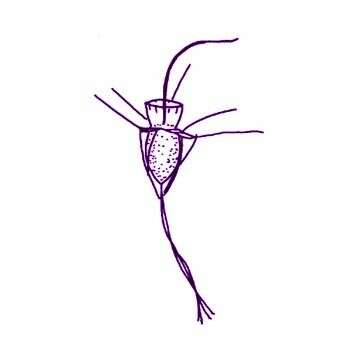
Calliacantha ankyra Thomsen, Garrison and Kosman, 1997. Cells are solitary. Protoplast (5-7x3-5 microns), pointed at the posterior end and with a single anterior flagellum (about 20 microns) surrounded by a collar of tentacles. Lorica chamber formed by 6 posteriorly converging longitudinal costal strips (8-11 microns) and anteriorly delimited by two closely spaced transverse costae (diameter 4-5 microns). Anterior joins between transverse and longitudinal costal strips are modified E-joins. The longitudinal costae continue above the anterior transverse costa as diverging projections, which are equal to one costal strip in length (9-12 microns). The aggregated pedicel is formed by two sets of bundled longitudinal costal strips. Two costal strips (8-12 microns long) typically form the uppermost set. The posterior most longitudinal costal strips (about 5, 8.5-11.5 microns long) diverge to form a better holdfast. Each strip is characterized by a swollen and clawed posterior tip. A protoplast suspensory membrane lines the lorica chamber. Division tectiform.
-

Calliacantha longicaudata (Leadbeater, 1975) Leadbeater, 1978. Choanoflagellates, lorica of which consists of a single chamber, 15-17 microns long x 6-8 microns wide, composed: of 5 (sometimes locally 4 or 6) longitudinal costae, each of 2 linearly attached slender cylindrical costal strips overlapping where they join, delimited anteriorly by 2 transverse costae, one terminal and the other parallel to it at about one sixth I of the length of the chamber behind it, transverse costal strips of both rings joined by their ends to the subtending longitudinal costae, at the posterior end, the longitudinal costae converging to subtend a caudal appendage of exceptional length (up to 100 microns) composed of up to 13 linearly attached costal strips overlapping at their ends and becoming thinner distally. The cell is enclosed by a conical membrane within the lorica chamber, attached to its base and equalling it in length, width when full 3-5 microns, the single flagellum exceeding 20 microns in length, surrounded by a ring of about 40 tentacles up to 6 microns in length, sometimes with terminal swellings.
-
This image was made from samples taken during a scientific cruise in the Pacific. Water was filtered to concentrate the organisms that were present, then dried onto a thin sheet of plastic and then shadowed with a fine layer of metal to provide contrast. The preparation was then observed with an electron-microscope. This technique has been used to document the diversity of marine microbes, especially, protists in the oceans.
-
This image was made from samples taken during a scientific cruise in the Pacific. Water was filtered to concentrate the organisms that were present, then dried onto a thin sheet of plastic and then shadowed with a fine layer of metal to provide contrast. The preparation was then observed with an electron-microscope. This technique has been used to document the diversity of marine microbes, especially, protists in the oceans.
-
Campyloacantha spinifera (Leadbeater, 1973) Hara and Takahashi, 1987. Solitary choanoflagellate, the lorica is about 12 - 14 microns long with 5 or 6 anterior spines, one transverse costa at the top of the lorica chamber and a short posterior spine.
-
This image was made from samples taken during a scientific cruise in the Pacific. Water was filtered to concentrate the organisms that were present, then dried onto a thin sheet of plastic and then shadowed with a fine layer of metal to provide contrast. The preparation was then observed with an electron-microscope. This technique has been used to document the diversity of marine microbes, especially, protists in the oceans.
-
Crucispina cruciformis (Leadbeater, 1974) Espeland in Espeland and Throndsen, 1986. Cell body obovoid, 3-5 microns long x 2-5 microns wide, single flagellum 14-20 microns long, funnel-shaped collar of about 30 tentacles 1-3 microns long. Lorica 12-17 microns high consisting of one chamber formed by one transverse costa and several longitudinal costae converging posteriorly to join with two divergent tapered spines. Two tapered spines projecting anteriorly from the transverse costa.


